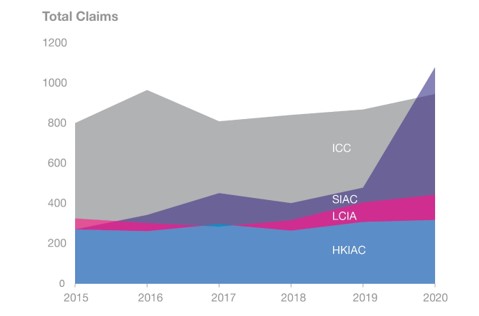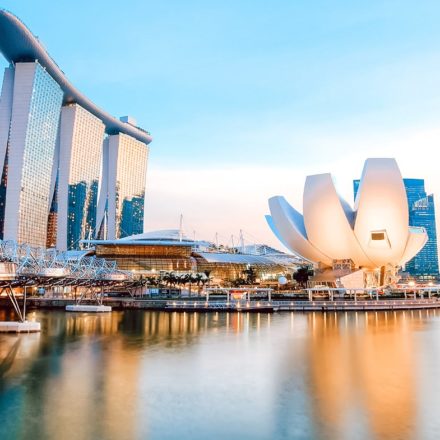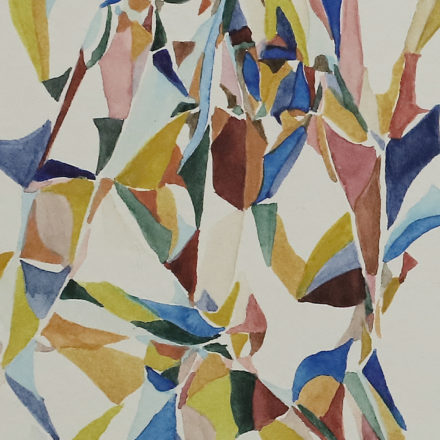The Singapore International Arbitration Centre (“SIAC”) has released its impressive statistics for 2020 with new cases topping 1,000 for the first time. Please click here for the report.

Some of the highlights include:
- From an annual average of 390 new arbitration cases filed each year since 2015 and a previous record of 479 new cases in 2019, last year saw an extraordinary increase with 1,080 new cases filed at SIAC. For the first time ever, this figure beats the number of new cases filed with the International Chamber of Commerce (“ICC”), which received 946 new cases and exceeds the number filed with the Hong Kong International Arbitration Centre (“HKIAC”), which received 318.
- The total value in dispute under these new cases amounts to USD8.49 billion – this is a little higher than 2019 (USD8.09b). The growth in the number of cases has not been matched by an equivalent increase in claims value with the average claim value falling significantly in 2020 (USD19.26 million) from 2019 (USD30.99 million). This suggests that the increase in new cases may be attributed to numerous lower value claims being filed. Nevertheless, the average total claims value for each year since 2015 is USD7.35 billion which again compares favourably with the HKIAC’s figures over the same period of USD5.5 billion. However, the figures for both institutes are put into the shade by those for the ICC which continues to attract the highest value claims with annual total claims values of more than 200 billion USD.
- Strangely the significant increase in the number of cases was not matched by an increase in arbitrator appointments but a decrease. In 2019, 297 arbitrators were appointed or confirmed by the SIAC. In 2020, 288 arbitrators were appointed or confirmed by the SIAC. There are a number of possible explanations: a large number of cases in which the tribunal is yet to be appointed due to delay by the parties in paying their deposits; a smaller number of arbitrations than appears on the face as SIAC allows arbitrations under associated contracts to be commenced in a single notice of arbitration (for the purpose of the case statistics these count as multiple cases); and arbitrations being commenced for limitation or settlement purposes only and then stayed.
- Singaporean parties continue to be the most represented at SIAC with 972 involved in new cases filed in 2020. Of foreign parties, India again takes top spot in SIAC’s statistics with 690 new cases filed in 2020. However, US parties are also showing a significant degree of engagement with SIAC with a new record number of 545 cases for 2020 (up from 65 in 2019). The SIAC opened a representative office in New York in December 2020 which will continue to drive this engagement.
- China takes third spot in the tables with a jump from an annual average over the last 5 years of about 70+ new cases to a total last year of 195 new cases. This is an important increase in numbers on its own but even more so when the number of claims involving parties from Hong Kong (60) is included; together they amount to 255 new cases filed involving Chinese parties in 2020. Singapore is becoming an increasingly popular forum for dispute resolution for Chinese parties given that this combined total of 255 new cases is not too far off the total number of new cases involving parties from all jurisdictions filed at the HKIAC last year of 318.
- A much more modest but similar trend can also be seen in relation to cases involving parties from Japan. Despite the fact that traditionally, Japanese parties have been reluctant to become embroiled in formal dispute proceedings, the number of Japan related cases doubled in 2020 – increasing from 23 to 46 new cases. Of significance in this context is the fact that in over 80% of these new cases, the Japanese party was the claimant – an indication that attitudes in corporate Japan towards using arbitration as a tool to resolve cross-border disputes are changing. Japanese parties are becoming less inclined to adopt a reactive/passive approach when problems arise and are being more aggressive in taking steps to protect their interests. This also reflects the greater emphasis and support being given by the Japanese government to encouraging the use of international arbitration to protect overseas investments. From SIAC’s perspective, this is considered particularly encouraging given that the cases involving Japanese parties tend to be high value claims arising out of substantial and complicated cross-border construction, infrastructure and energy related projects as well as those from areas such as high tech and pharma.
- Other top ten foreign users at SIAC in 2020 included Switzerland (135 cases), Thailand (101 cases), Indonesia (85 cases), Vietnam (52 cases) and Cayman Islands (42 cases). The Philippines which was the second largest foreign user in 2019 with 122 cases had a mere involvement in 14 cases in 2020.
- Interestingly, the increase in SIAC’s figures appears to be dominated by trade related disputes – which account for 64% of the total of new cases filed in 2020 (an increase from just 21% the previous year). Cases from other industries such as shipping remain in single digits, and notably, construction and infrastructure related cases make up just 4% of the new cases (a drop from 16% the previous year). SIAC has explained this apparent decrease in the number of new construction related cases by noting that the large increase in trade related cases has distorted the numbers for new cases from other industries. This is true but in absolute terms the number of construction cases decreased from 76 in 2019 to 49 in 2020. There has also been a relative and absolute decrease in corporate cases from 140 (29%) in 2019 to 80 (7%) in 2020. Both corporate and construction cases tend to be higher value, multi-party claims and the decrease in these cases may explain the drop in average claim value.
While these figures would be impressive in any year, they are particularly so given the challenges posed by COVID-19. Working with Maxwell Chambers, SIAC were quick to adapt to the need for remote hearings and new ways of working, publishing COVID-19 case management updates and a remote hearings practice guide last year.
The Queen Mary international arbitration survey of 2018 found that Singapore was the third most popular seat globally for international arbitration (behind London and Paris) and SIAC was the third most popular arbitral institute in the world after the ICC and the LCIA, these latest results from SIAC suggest that the gap in these global tables is closing quickly. We expect this to continue given that SIAC is continuing to expand overseas with offices in the US, India, South Korea and China, the growing importance of the ASEAN economy as a destination for foreign investment and Singapore’s increasingly dominant position as the preferred international dispute resolution forum in Asia.







